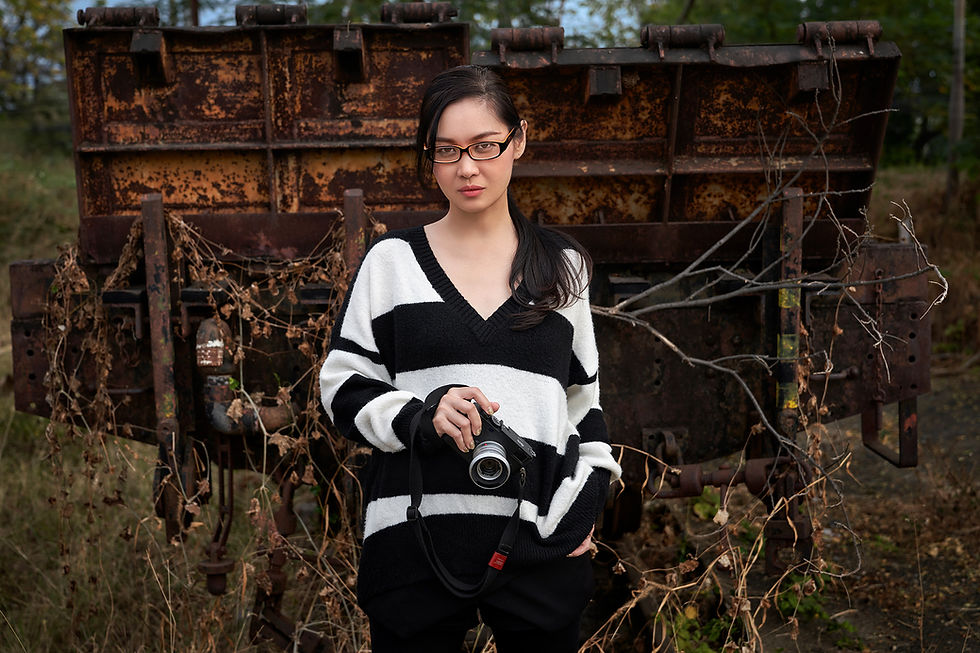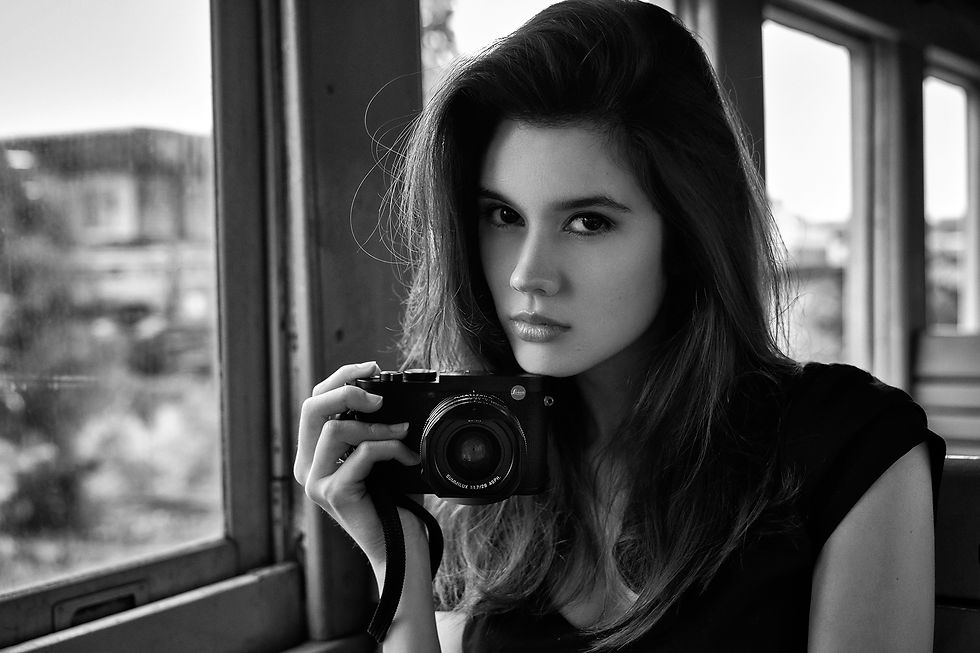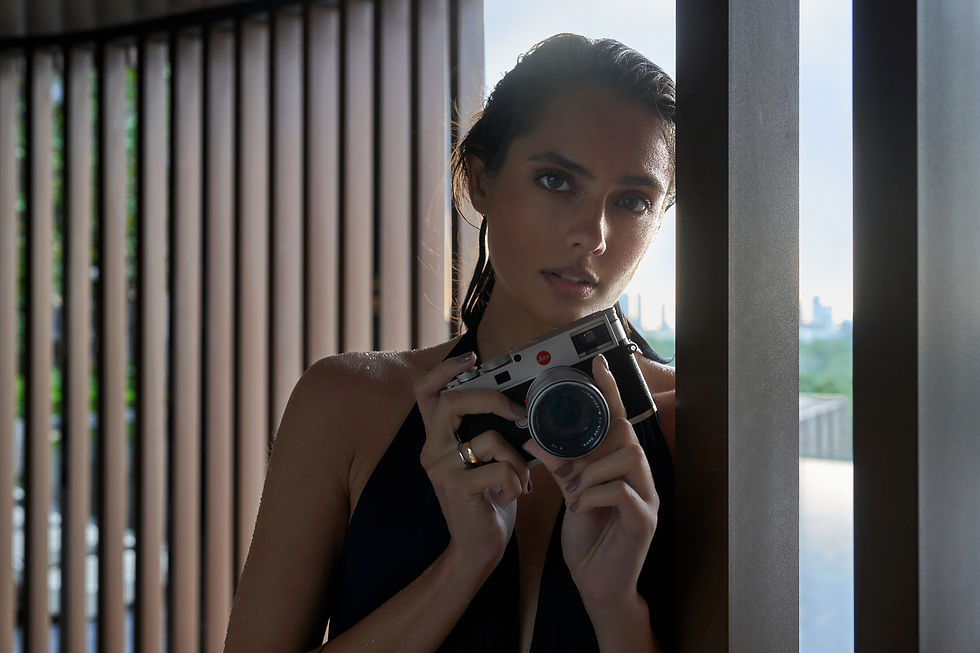Behind and in front of my camera
- Kaisern Chen

- Jan 8, 2019
- 16 min read
Updated: Nov 22
A camera was once perceived as a magical and obscure device many believed it will capture and take away the soul of the person on the picture; as a photographer and an industrial designer, it is a very fascinated tool because at the instant of exposure everything was put to work to result in a picture.
The camera has become much easier to use coming to the digital age and even more comfortable when basically all smartphones have at least one or two cameras.
This blog is a collection of varies images I took with a person behind and in front of my camera.





A camera is a tool for learning how to see without a camera.
~ Dorothea Lange



A portrait is not made in the camera but on either side of it.
~ Edward Steichen


An image captured on camera represents an individual record seen by the photographer's eyes.
~ Eraldo Banovac





Great photography is about depth of feeling, not depth of field.
~ Peter Adams



The best thing about a picture is that it never changes, even when the people in it do.
~ Andy Warhol






Leica MP - The best Leica camera ever made as far as traditional photography is concerned, IMHO. The original MP introduced in 2003, about 50 years after the Leica's M3 (1954). The MP stands for a rather bold claim "Mechanical Perfection" which 16 years later still stands strong and remains in production as of today (April 2019).
Some might argue that the newer M-A introduced in 2014 is the better example of a purer mechanical example than the original MP but except the slightly brighter rangefinder viewfinder by eliminating the part that is reflecting the metering diodes into the frame, all else are basically the same. My preference for original MP over M-A is that both are essentially a purely mechanical camera with the MP has the option of using a battery to power the meter or remove it, so it is no different than an M-A.
The MP, held in the hand of lovely Argentinean model Betina, is an à la carte edition of MP I commissioned Leica to custom-make for my birthday, black-paint MP with the removal of front and top engraving to make the camera looks as essential as it works.
The unmistakable acoustic signature of the shutter release of such purely mechanical camera immediately reveals the precision-engineered excellence of a photography tool that bears the claim of "Mechanical Perfection"!
More educational and interesting review by Erwin Puts. a fine gentleman just passed away in early 2021, his works will be remembered by many.



A photograph shouldn't just show you a person. It should also show you their soul.
~ Anthony T. Hincks





Leica M Edition 60 introduced initially at Photokina 2014 on the 60th anniversary of the legendary Leica M rangefinder system. The commemorative limited edition is a special version created by Audi Design that pays homage to the essence of photography and carries it back to its origins. It is one of my favorite M cameras for its clean and simplicity look as the first digital M camera without a rear screen. A camera I enjoy shooting very much until the introduction of Leica M10-D as my most often use Leica M camera. https://www.kaisernchen.com/post/leica-m10-d-diary




Leica M5 is the only Leica M camera I owned but never make any shot with. It is a very well built camera and the last Leica M camera entirely made in Germany by hand using the traditional adjust and fit method. It is bigger and heavier than the regular film M cameras and with a slightly different design that many regarded less elegant which I agree. Leica was in cross-road again to try to give the M5 as many improvements as possible over M4 back in 1971 when M5 was introduced.
It was not a success camera for Leica although it is technically one of the best Leica M ever made.
It is life.



No one ever takes a photograph of something they want to forget.
~ Seymour Parrish




It's one thing to take a picture of what a person looks like, it's another thing to make a portrait of who they are. ~ Paul Caponigro

The M Monochrom model Typ 246 Jim Marshall Edition is one of the most recognizable M cameras by implementing a special "Laiton" finish which provides a unique matt finish each with one of a kind appearance from the individual hand-rubbing process. The DNG file from the MM246 provides extra depth of resolution and tonal transition to standard RGB based sensor (Bayer to RGB demosaicing) therefore eliminating the pattern and color noise. It is also unique in its capability of real monochrome video recording. It is one of my favorite Leica M cameras.






I believe in living with the camera, and not using the camera.
~ Dotothea Lange




My life is shaped by the urgent need to wander and observe, and my camera is my passport.
~ Steve McCurry





We are making photographs to understand what our lives mean to us.
~ Ralph Hattersley






Maria Klepikova selfie with the 1954 Leica IIIf RD, a camera two generations camera older than Maria, is one of the oldest Leica in my collection. The original Leica IIIf introduced in time for Christmas 1950 matches the red color of the bodysuit nicely. The old camera pairs with Maria and the Andy Warhol space theme at the Fotoclub Bangkok very well and thanks Maria's beautiful pose to connect all the elements that work well as a picture.




Photography is the art of making memories tangible.
~ Destin Sparks

My Leica M10 Monochrom in the hand of the lovely Thai dancer, Fai Panasorn Khaophong - the signature of classical Thai dancers (Ramthai) long and bend fingers.







MP - The mechanical perfection
It is probably safe to assume most Leica users today shoot digital Leica primarily, and maybe most of them started with a digital Leica. It is also safe to think that most Leica users have a particular desire for owning vintage Leica film cameras whether or not to use them.
Since 1925 Leica has introduced tens of different serial models that each photographer has his favorite, prefer one over another. However, the Leica MP is always high on the wish list as it is a purely mechanical camera with the option of electronic TTL metering when installing a battery. It has remained in production since its introduction in 2003 to the present day. Leica gave the MP the claim "Mechanical Perfection"; bold, but few would disagree.
It is one of the hallmarks of mechanical instruments. Hundreds of parts synchronize rhythmically at a shutter press; such tactile response bonds the users a deep connection to the camera, almost an addiction.
Leica MP is one of my favorite Leica; even though I don't use it often anymore, I still keep a few of them, such as the Hammertone MP LHSA Edition and the a-la-carte MP held by the lovely Daria in this picture.
The MP is the kind of camera that you know will undoubtedly outlast you once you have one in your hand.



System cameras are among those few objects where brand loyalty is best exemplified in modern times. The logic behind such a phenomenon is probably the system camera is a building-up process, and users are locked within the brand ecosystem, making switching brands harder as the system grows. The debates of system superiority follow suit among all levels of users, on all things related to the gears they are defending, while photography is often ignored.
However, there are exceptions.
Nikon FM2 is one such example.
Nikon FM2 rapidly gained trust and popularity among professionals and advanced photographers since its release in 1982 and established its iconic camera status over time, almost without dispute.
I used to have three FM2 series cameras, two black FM2 with MD-12 winder to use along with my F3 in the '80s and '90s, and later added the Titanium FM2T simply for the sack of possession.
It is a camera that most photographers want, regardless of the brand of camera they use.

The Hansa Canon in Miss Natthida Duangjampa's hand is a scaled model I bought in 2012, about a decade ago, as a release to celebrate the 75 anniversary of the famous Canon.
The Seiki Kōgaku Kenkyūjo (精機光学研究所, or Precision Optical Instruments Laboratory), Tokyo, Janapn, manufactured the original camera that would eventually become Canon. The lens attached to the original Hansa Canon was a Nippon Kōgaku 日本光学 Nikkor f:3.5 5cm.
It was the time the Japanese industry followed the jikyu jisoku “自給自足” - self-sufficiency goal for manufacturing independence to pave the road to building the Japanese Empire.
Japanese optical and camera industry benefitted from recruited German scientists following World War I, which ended with Germany's economy destroyed and many people out of work. Total of eight German engineers came to work for Nippon Kōgaku in 1921, with families which housing and whatever needed to uproot their lives in Japan. Heinrich Acht and Professor Max Lange were among them and were responsible for product design and engineering and optical design, respectively. Eventually, the Japanese camera and optical industry infused with the German gene that later enabled them to become a rivalry to top German companies like Zeiss, Leitz, and Schneider. Now they are the dominant force and the leader on all fronts.
The Canon EOS digital camera was my primary 24X36mm system back in 2012 when I bought this model Hansa Canon. It is not the case today. I have been using various and multiple system cameras for decades. I stay with the logic of what works best.

Leica M Monochrom Typ 246 was the second Leica M camera with the proprietary Monochrom CMOS sensor after the original Leica M Monochrom (CCD) and before the M10 Monochrom. I am lucky enough to have all the Monochrom models and enjoy shooting with them. The MM246 remains the only Leica Monochrom capable of recording real monochrome video, albeit at a modest 1080p at 30fps.
The Leica Monochrom cameras are desirable and effective tools for creat high-quality monochrome images; however, cameras with color sensors are also very competitive and sometimes more flexible choices for monochrome images using software conversion.
By statistics, most of my monochrome images were created through the conversion of color files, albeit I own all three generations of Leica Monochrom cameras. It is not a testimony that I value color cameras over Monochrom models for black and white images, while I do believe color cameras are competitive tools with flexibility. Leave the camera alone; let the picture speaks.

The painter constructs, the photographer discloses.
~ Susan Sontag






Photography takes an instant out of time, altering life by holding it still.
~ Dorothea Lange




The Honeywell Spotmatic is the US-imported version of the Asahi Pentax Spotmatic launched in 1964, about 80 years ago, Miss Kimiga nicknamed it "Grand-pa camera", she is not over-exaggerated.
The Spotmatic was initially presented at Photokina 1960 as the first reflex camera with TTL metering - originally designed to use spot metering but changed to center-weighted average, however, the "Spotmatic" name prevailed.
Pentax was late to the camera business but played aggressively for as long as the company's resources can last, and a short-run after Ricoh acquired all shares of Pentax Imaging Corp. in 2011. Pentax's spirit has been offering the very latest technology which is common for those who are not in the leading position.
The camera in Miss Kimaga's hand once was a symbol of technology statement but now signifying, as the current owner pertaining it to be - retro and nostalgic, as many young photographers "found" the film to be, and try to associate with the film to differentiate from the mass, which in general has nothing to do with photography art.
Let the photograph speaks! Not the camera.









Veronica Butalina, an independent musician based in Yaroslavl City, Yaroslavl Oblast, Russia, who composed her own scores, recording her own play of instruments and vocal.
Veronica became a friend of mine purely by accident as she was a member of a music band, before she turned independent, performing on a private Volga River Cruise where a good friend of mine threw a birthday party that included the live band and singing which Veronica was a part of. It was at beautiful sunset time that I was on the top deck of the cruise taking pictures and spotted a lovely young girl in light purple dress that matches the ambient color of the beautiful August sunset in northern Russia, I had to take some pictures of her! And so started the never ending photo sessions each time I visited this part of Russia.
Veronica came all the way from her city, Yaroslavl, about 80km away, to visit me in Rybinsk, to have some conversations, coffee and of course pictures! Again around the place I stay, right on the bank of the beautiful Volga River.
Veronica practices photography from time to time, and my Leica M11 fits right in her hand!








The KONI-OMEGA Rapid 100 - a medium format rangefinder camera known for its robust build and excellent image quality. It features interchangeable lenses and a film back system, allowing for flexibility in shooting. The camera uses 6x7 roll film, which provides large negatives ideal for high-resolution prints. Popular among enthusiasts for its precise engineering and classic design, the KONI-OMEGA Rapid 100 is prized for both studio and field photography.

The Linhof Master Technika is a renowned large format field camera celebrated for its German design, precision engineering, and adaptability. Its foldable design ensures portability without compromising its robust construction. The camera offers extensive movements, such as tilt, shift, and swing, allowing photographers precise control over perspective and focus.
Designed for sheet film, the Master Technika accommodates a wide range of lenses and accessories, including digital capture backs with sliding movement for stitched larger-format or panoramic images, making it versatile for various photographic needs. It is particularly favored in landscape, architectural, and studio photography, where high-quality, detailed images are essential. Its craftsmanship and reliability make it a staple among professional photographers. Mastering the Master Technika is truly a lesson in mastering photography itself.





Violetta Eshtokina and Her Lomo Smena 8M – A Companion for the Young Generation
The term "Smena" (CMEHA - Смена) translates to "Change" or "Shift" in Russian, but it is also closely associated with the concept of the "Young Generation," aptly reflecting the target market for this iconic camera. Produced from 1952 until the late 1980s, the Lomo Smena achieved remarkable popularity, with a total of 21 million units sold, making it the best-selling single camera model of its time.
For Violetta, her Smena 8M holds special significance—it was a gift from her mother and has become her trusted companion on her travels. With this camera in hand, Violetta captures her adventures and memories, embodying the spirit of exploration that the Smena brand represents.

At Benchakkiti Park in Bangkok, little Ruth, the daughter of Burmese immigrants, revels in her surroundings while dressed in her festive Christmas outfit. With a bright smile, she holds her toy camera, imagining capturing the park's beauty and every moment that brings her joy. Ruth embodies the spirit of childhood curiosity and creativity, celebrating her heritage and the magic of the season.






Natasha Friesen, Bangkok, Thailand May 2025
Polina Zolotko with her Olympus-PEN - In the early 1970s, Olympus was determined to make a significant impact in the world of photography, and at the forefront of this mission was Yoshihisa Maitani, a visionary designer. While he gained recognition for the groundbreaking OM-1, a compact single-lens reflex camera that revolutionized the market, it was the revival of the PEN series that truly captured his imagination.
Maitani envisioned a modern Olympus PEN that would appeal to a new generation of photographers. He aimed to create a camera that combined the charm of the original PEN with contemporary technology, emphasizing portability and high-quality performance. His design team meticulously crafted every detail, ensuring the new PEN was sleek, stylish, and user-friendly, featuring a mirrorless system that allowed for easy handling without sacrificing image quality.
The launch of the new Olympus PEN was met with enthusiasm, quickly becoming a favorite among photographers around the world. It embodied Maitani's philosophy of making photography accessible and enjoyable for everyone, encouraging users to effortlessly capture life's moments.
While the OM-1 established Olympus as a leader in camera design, it was the new PEN that solidified Maitani's legacy. Together, these cameras showcased his commitment to innovation and creativity, leaving an indelible mark on the photography landscape that continues to inspire enthusiasts today.






just a small collection some useful tools
What a beautiful collection of these very expensive cameras with good-looking models in behind.